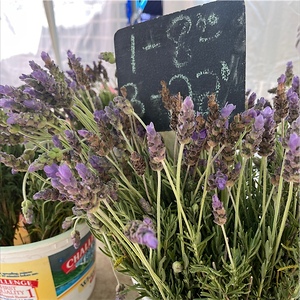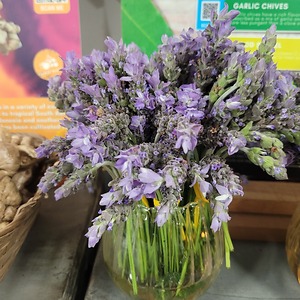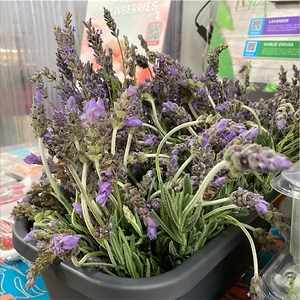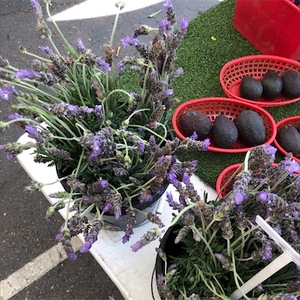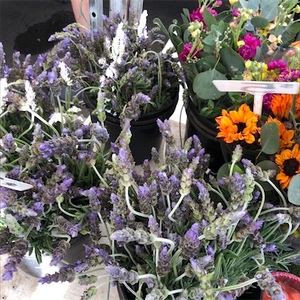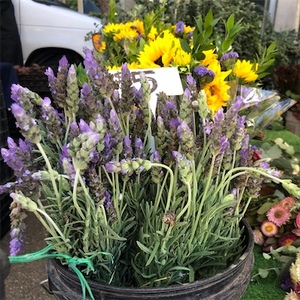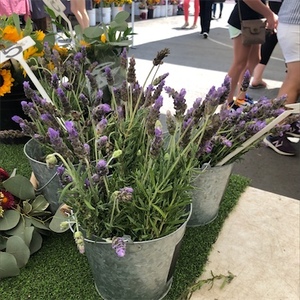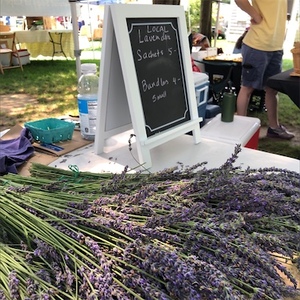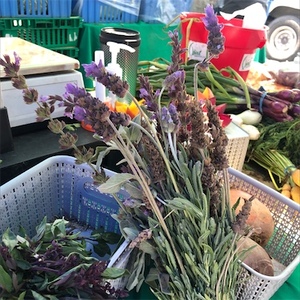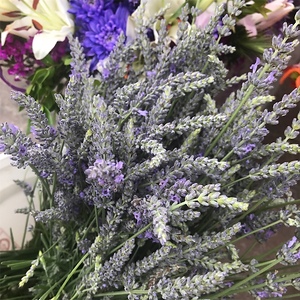


Lavender Wand Flowers
Estimated Inventory, 50 ct : 0
| Fresh Origins | Homepage |
Description/Taste
Lavender wands are long and thin, measuring 10 to 15 centimeters, and are comprised of light purple flowers attached to the tip of a delicate and supple stem. The stems may or may not have a few long, deeply-toothed leaves. The top third of the wand is dotted with tiny flower buds containing 2 to 4 ovate petals, the majority of which remain tightly closed except near the top, where soft and wispy petals appear. Lavender wands are highly aromatic with a crisp and clean, slightly woodsy fragrance. Each bloom delivers a sweet and floral flavor with a mild menthol and camphor finish.
Seasons/Availability
Lavender wands are available year-round, with a peak season in summer.
Current Facts
Lavender wands extend from bushy ornamental shrubs, botanically classified as Lavandula. Lavender is a member of the mint family and is highly prized for its beautiful purple blossoms and fragrant aroma. The name lavender is derived from the Latin ‘lavare’ meaning “to wash,” a suiting name for the flower since it is used extensively in producing soaps, lotions, and perfumes. There are 39 different species of lavender, but only two varieties are commonly used for culinary purposes. Lavandula angustifolia, known as English Lavender or true lavender, has a sweet and floral flavor with small clusters of purple-blue flowers and narrow leaves. Lavandula x intermedia, known as Lavandin or French lavender in the United States, is a hybrid species that has a strong camphor-like scent and herbaceous flavor similar to rosemary with jagged leaves that are used as an herb. Lavender wands can be harvested from either variety. While the leaves of the lavender plants are edible, lavender buds are used more often for culinary purposes because they have a more robust and sweeter flavor than the leaves, which are less fragrant with a bitter taste. Lavender will grow year-round in warm winter climates, although flower production will lessen during the colder months. Lavender flowers can also be dried and used in culinary applications as well as in the production of cosmetics and potpourris.
Nutritional Value
Lavender flowers contain trace amounts of vitamin A to support vision, reproduction, and immunity, and vitamin E, an essential antioxidant in the body that helps reduce inflammation and support the immune system. The buds are also high in other antioxidants and have been used for centuries as a calming aid. Research shows that the linalool present in Lavender can help with relaxation and the reduction of anxiety. It can also be used as a sleep aid and to soothe headaches, migraines, and motion sickness.
Applications
Lavender wands add a crisp, sweet, and floral flavor and are suited as an edible accent, added at the end of preparation to maintain their delicate shape and texture. The entire wand is edible and can be used whole, or the individual buds can be separated and spread throughout a dish. Lavender flowers can be used to top salads and curries or mixed into fruit bowls. The flowers can be added to sugar cookies, shortbread, scones, and cakes for a pop of flavor and color, or they can be mixed into butter or pressed into cheeses. The intact wands can be used to garnish cakes, cheese boards, and fruit displays or used as a cocktail stirrer. Lavender can also accent desserts such as sorbets, crème brulee, ice cream, puddings, and tarts. The fragrant buds do well in spice rubs for poultry, and in citrus gastriques used to glaze seafood. They can also be added to salad dressings and marinades for spring vegetables or added to honey and drizzled on fresh goat cheese or yogurt. Lavender is popularly infused into vinegar, simple syrups, salts, and sugars. Lavender wands pair well with chocolate, fruits such as coconut, strawberries, lemons, passionfruit, mango, and cherries, herbs including rosemary, parsley, and mint; cheeses such as goat, brie, and blue; leafy greens, and springtime vegetables including asparagus, peas, green garlic, and fava beans. The flowers should remain attached to the stem as long as possible and used within 48 hours for best quality.
Ethnic/Cultural Info
The history of folklore surrounding Lavender is extensive. The herb and flowers have long been synonymous with cleanliness. Before the understanding of the science behind germs, disease and illness were often believed to be caused by the presence of evil, so it is no surprise that Lavender would become a tool for warding off evil. During the Dark Ages, a period stretching from 500 CE to 1000 CE, the herb was used to protect from the evil eye, a curse whose origin dates to 3000 BCE. The curse was brought on by a glare that would cause the victim to have bad luck or experience loss. Often, this glare was cast unknowingly by those feeling envious of another, so it was important to always have a ward against this look on hand. Through time, the evil eye became a catch-all to explain any misfortune, including bad luck, ill health, accidents, drought, and famine. The belief in Lavender as protection against evil continued into many different cultures. In pagan customs, the herb was used on the winter solstice to protect from evil during the longest night of the year, and in Christian folklore, a cross of Lavender was hung over the door to prevent evil from entering the home. In modern society, Lavender is still added to sprays and potpourri for purification and relaxation and placed in bouquets and simmers during the winter solstice and yule celebration.
Geography/History
Lavender is originally native to the Northwest regions of the Mediterranean, Middle East, and India, where the plants thrive in the arid and mountainous climates of these areas. The flowers have been used as medicine and as a hygiene product for more than 2,500 years. Ancient Egyptians used the fragrant blooms during the embalming process, and Ancient Greeks and Romans added dried flowers to perfumes and soaps. Lavender spread quickly along trade routes throughout Europe and Africa. Early colonists brought the plants to North and South America, where they naturalized throughout the United States and Mexico. Lavender grows well in a variety of climates and is cultivated across Europe, Australia, New Zealand, and North and South America. Lavender wands can be found throughout these regions during the summer months at stores, farmer's markets, and roadside farm stands.
Recipe Ideas
Recipes that include Lavender Wand Flowers. One
| She Knows |
|
Lavender Lemonade |
| The Mountain Rose Blog |
|
Flower Infused Ice Cream |




 Learn More...
Learn More...